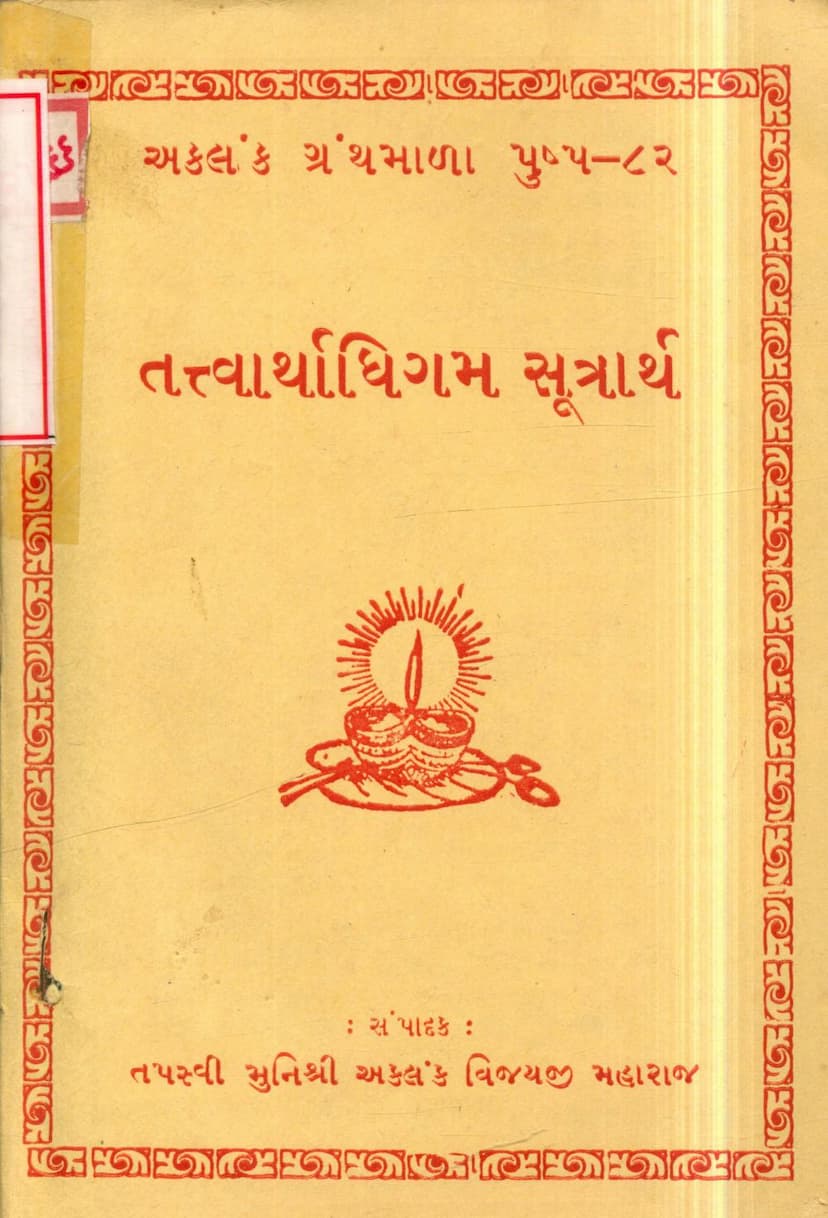Tattvarthadhigam Sutrarth
Added to library: September 2, 2025

Summary
This document is a Gujarati book titled "Tattvarthadhigam Sutrarth" (તત્ત્વાર્થાધિગમ સૂત્રાર્થ) edited by Tapasvi Munishri Akalank Vijayji Maharaj. It is published by Akalank Granthmala. The book appears to be a detailed commentary or explanation of the Tattvartha Sutra, a foundational text in Jainism.
Here's a breakdown of the content based on the provided pages:
Key Information and Content:
- Title: Tattvarthadhigam Sutrarth (તત્ત્વાર્થાધિગમ સૂત્રાર્થ)
- Author/Editor: Tapasvi Munishri Akalank Vijayji Maharaj (તપસ્વી મુનિશ્રી અકલક વિજયજી મહારાજ)
- Publisher: Akalank Granthmala (અકલંક ગ્રંથમાળા)
- Purpose of Akalank Granthmala: The publisher aims to print excellent Jain religious books and seeks donations and memberships for this cause, emphasizing "Gnanadan Sarvokrusht Daan" (knowledge donation is the best donation). They offer patronship and lifetime memberships, with names being published in the books.
- Prastavana (Preface): The preface highlights the Tattvartha Sutra as a very popular and important text by Shri Uma Swatiji Maharaj. It states that the sutra encapsulates the essence of Jain scriptures. The preface acknowledges the depth and complexity of the Tattvartha Sutra and mentions that many scholars have written commentaries on it. It also praises Munishri Akalank Vijayji for his dedication to publishing Jain literature.
- List of Supported Books: Several pages list books published or supported by Akalank Granthmala, covering a wide range of Jain literature, including lives of Tirthankaras, Jain stories, scriptures, and commentaries.
- Author's Biography (Munishri Akalank Vijay): A section provides a brief biography of Munishri Akalank Vijay, mentioning his birth date, secular name (Amrutlal Shivlal Shah), his religious teachers, his initiation into monkhood, and his current activities focused on writing and editing Jain texts.
- Financial Contributors: Lists of individuals and institutions who have provided financial support for the publication of Tattvarthadhigam Sutrarth and other books by Akalank Granthmala are provided.
- Content of Tattvarthadhigam Sutrarth (Chapter-wise Summary): The subsequent pages provide detailed explanations of the Tattvartha Sutra, organized into chapters:
- Chapter 1: Samyakdarshan, Samyakgnan, Samyakcharitra - Discusses the path to liberation (Moksha Marg) through right faith, right knowledge, and right conduct. It delves into the nature of these elements, their interdependence, and the stages of spiritual progress (Gunathana). It also explains different types of knowledge (Mati, Shruta, Avadhi, Manahparyaya, Keval) and the classification of knowledge and ignorance. The concept of Naya (perspectives) and Pramana (valid means of knowledge) is also touched upon.
- Chapter 2: Upashamik, Kshayik, Kshāyopashamik Bhava - Explains the different states or modes of existence of the soul (Bhava), categorizing them as Upashamik, Kshayik, Kshāyopashamik, Audayik, and Parinamik. It details their sub-categories and their relation to the stages of spiritual development (Gunathana).
- Chapter 3: Description of Naraka (Hell Realms) - Describes the seven hell realms, their characteristics, the types of beings residing there, their suffering, lifespan, and the karmic consequences leading to rebirth in these realms. It also provides a cosmology of the Jain universe, describing the different lokas (worlds), Meru Parvat, and the arrangement of the universe.
- Chapter 4: Description of Devas (Celestial Beings) - Details the four types of celestial beings: Bhavanpati, Vyantar, Jyotishi, and Vaimanika. It explains their divisions, lifespan, senses, subtle bodies, karma, and the celestial realms they inhabit, including their hierarchy and powers.
- Chapter 5: Ajiva Dravya (Inanimate Substances) - Explains the five inanimate substances (Ajiva Dravya): Pudgala (matter), Dharma (principle of motion), Adharma (principle of rest), Akasha (space), and Kala (time). It delves into their characteristics, states, and interrelationships.
- Chapter 6: Ashrava (Influx of Karma) - Describes Ashrava as the influx of karma into the soul, caused by the actions of mind, speech, and body, influenced by passions (Kashaya) and senses. It details the types of Ashrava (Shubha/punya and Ashubha/papa) and the various actions that lead to karmic bondage.
- Chapter 7: Vrata and Their Transgressions - Explains the five great vows (Mahavrata) and the vows of lay followers (Anuvrata), along with their associated virtues and transgressions (Atichara). It emphasizes the importance of right faith and conduct for spiritual progress.
- Chapter 8: Causes and Types of Karmic Bondage - Details the causes of karmic bondage (Mithyadarshana, Avirati, Pramada, Kashaya, Yoga) and the four types of bondage: Prakriti (nature), Sthiti (duration), Rasa (intensity), and Pradesha (quantity). It further categorizes the karmas and their numerous sub-types.
- Chapter 9: Samvara and Nirjara (Cessation and Shedding of Karma) - Explains Samvara as the stopping of karma influx through control of senses, mind, speech, and body (Gupti, Samiti), and the practice of virtues, contemplation, and austerities. Nirjara is described as the shedding of accumulated karma through various means, including penance and virtuous living. It details the types of Samvara and Nirjara and the stages of spiritual progress where they are practiced.
- Chapter 10: Moksha (Liberation) - Describes the ultimate goal of Jainism, Moksha, as the complete annihilation of all karma and the soul's attainment of its pure, liberated state. It explains the conditions for liberation, the nature of the Siddha soul, and the process of spiritual evolution leading to Moksha.
Overall, this book is a comprehensive Jain scripture that aims to provide a detailed understanding of the core principles of Jainism, particularly as outlined in the Tattvartha Sutra. It covers the path to liberation, the nature of the soul and matter, the workings of karma, and the celestial and infernal realms. The publication is a part of a larger effort by Akalank Granthmala to spread Jain knowledge through literature.